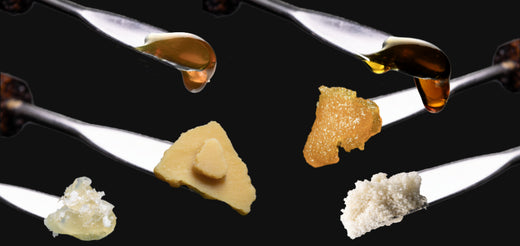Types of Cannabis Dabs

The proliferation of different types of dabs in the cannabis market reflects the growing popularity of cannabis concentrates both for producers and consumers.
Dabbing involves using a dab tool to place a small amount of cannabis concentrate on a heated dab nail so that it vaporizes. The vapor is then inhaled. Concentrates vaporize at a lower temperature and provide a more intense and flavorful experience than smoking flower.
Dabbable BHO concentrates were initially popularized in 1999 after Indra Gurung posted about this extraction technique on the underground website Erowid. Solventless dabs have risen to prominence since rosin pressing was discovered by Phil “Soilgrown” Salazar in 2015.
Understanding the different types of dabs is helpful both for entrepreneurs looking to produce cannabis concentrates professionally and cannabis enthusiasts looking to enjoy the cannabis plant in new ways.
Types of Dabs Made with Solvent Extraction
Solvents used to make cannabis concentrates typically include ethanol, isopropyl alcohol, and CO2 as well as hydrocarbons like butane, propane, and hexane.
Nonpolar solvents like hydrocarbons typically produce “cleaner” and more potent extracts than polar solvents like ethanol because they dissolve the most desirable compounds (cannabinoids and terpenes) and leave less desirable compounds like chlorophyll behind.
Customers who are just learning how to dab cannabis are often attracted to solvent-based extracts because they sell at a lower price point than their solventless counterparts.
Important: Producing solvent-based extracts safely requires professional closed-loop extraction equipment and a C1D1 room. Do not attempt to make hydrocarbon cannabis extracts at home.
Live Resin
Live resin is a cannabis extract that is made from fresh frozen cannabis plants rather than dried plant material. Passing solvents through cannabis plant material that was frozen at the time of harvest results in an extract that is especially rich in terpenes, as terpenes tend to degrade during the drying and curing process.
Live resin is considered the most premium solvent-based cannabis concentrate because of its potency and complex flavor profile. If you are interested in making solvent extracts, live resin is the way to go.
Non-Live Solvent/Hydrocarbon Textures
The types of dabs listed here can be made with various blends of light hydrocarbons including butane, isobutane, propane, and hexane. Dabs made using butane extraction are referred to as butane hash oil (BHO).
1. Shatter
Description: A glass-like, brittle texture that shatters easily.
Production:
- The extract is cooled rapidly to stabilize the cannabinoids.
- Thin sheets are formed, resulting in a translucent, amber-colored product.
- Often involves vacuum purging to remove residual solvents without agitation, maintaining a smooth consistency.
2. Wax

Description: Soft, opaque, and crumbly texture resembling candle wax.
Production:
- The extract is whipped or agitated during the purging process.
- This process introduces air, resulting in a softer, more opaque texture.
- Purging is done at slightly higher temperatures and with agitation to achieve the waxy consistency.
3. Budder

Description: Creamy, buttery texture that is softer and more pliable than wax.
Production:
- Similar to wax, but with more vigorous whipping or agitation during purging.
- The additional whipping introduces more air, creating a creamier texture.
- Purging is done at a controlled temperature to achieve the desired consistency.
4. Crumble
Description: Dry, crumbly texture that breaks apart easily.
Production:
- The extract is whipped and purged at a lower temperature and longer duration.
- The whipping process introduces air, but the lower temperature causes the extract to dry out more, resulting in a crumbly texture.
- Often involves a higher degree of agitation compared to wax or budder.
5. Honeycomb
Description: Light, airy texture with a honeycomb-like appearance.
Production:
- Similar to crumble, but with a slightly different purging process that creates larger air pockets.
- The extract is whipped and purged under vacuum at a specific temperature to form the honeycomb structure.
6. Live Resin
Description: Sticky, terpene-rich extract that retains more of the plant's original flavors and aromas.
Production:
- Freshly harvested cannabis is flash-frozen to preserve terpenes.
- The frozen plant material is then extracted using hydrocarbons.
- The extract is purged at low temperatures to retain the volatile terpenes, resulting in a more aromatic and flavorful product.
7. Sauce
Description: Viscous, liquid-like consistency often containing THCA crystals in a terpene-rich sauce.
Production:
- The extract is processed and allowed to separate into two components: high-terpene extract (sauce) and THCA crystals.
- The mixture is purged at low temperatures after the initial extraction process to preserve terpenes while encouraging the formation of crystals.
- The resulting product is a combination of crystals suspended in a terpene-rich liquid.
8. Diamonds
Description: Solid THCA crystals, often combined with terpene sauce.
Production:
- The extract is processed to allow the formation of THCA crystals.
- The solution is left undisturbed to enable crystal growth, which can take several weeks.
- The crystals are often combined with a small amount of terpene sauce for added flavor.
9. Snap and Pull
Description: A texture between shatter and taffy, more pliable than shatter but still snaps.
Production:
- Purged at a specific temperature and time to achieve a consistency that is pliable yet brittle.
- Less agitation compared to wax or budder to maintain a semi-stable form.
10. Sugar

Description: Grainy, sugar-like consistency with high terpene content.
Production:
- The extract is whipped or agitated, similar to wax or budder, but purged to a point where small, crystal-like formations occur.
- The final product has a wet, sugary texture, often with a high terpene content for enhanced flavor.
11.Badder
Description: A smooth, batter-like texture that is soft and creamy.
Production:
- Solvent: Butane is used as the primary solvent for extraction.
- Initial Extraction: The plant material is soaked or passed through butane, dissolving the cannabinoids and and terpenes.
- Purging: The resulting solution is purged of butane, leaving behind a highly concentrated form of cannabis extract.
- Whipping and Agitation: The extract is whipped and agitated during the purging process to achieve its characteristic smooth, batter-like consistency.
12. Rick Simpson Oil (RSO)

Description: A thick, dark, and viscous cannabis extract known for its high potency and full-spectrum cannabinoid profile.
Production:
- Solvent: Typically uses isopropyl alcohol or ethanol.
- Initial Extraction: Dried cannabis plant material is soaked in the solvent, which dissolves the cannabinoids, terpenes, and other plant compounds. The mixture is agitated to ensure thorough extraction of the desired compounds.
- Straining: The plant material is then strained out, leaving a solution of the solvent and cannabis extract.
- Evaporation: The solvent is evaporated off, often using a rice cooker or a similar heating device, to reduce the risk of overheating and preserving the extract's integrity.
- Final Purging: The remaining thick oil is further purged to ensure all residual solvents are removed, resulting in a highly concentrated oil.
Characteristics:
- Consistency: Thick and sticky, similar to molasses.
- Color: Dark brown to black, due to the full-spectrum nature and the method of extraction.
- Potency: Extremely potent, with a high concentration of THC and other cannabinoids.
- Full-Spectrum: Contains a wide range of cannabinoids, terpenes, and other plant compounds, making it a full-spectrum extract.
Dabs Made Using Solventless Extraction Methods
Solventless extraction methods can be used to make dabs that are every bit as potent and flavorful as solvent extracts.
Dry Sift
Dry sift consists of the trichomes of cannabis flowers that are intentionally removed from the plant via sifting or tumbling. The extract can be further refined by sifting it through finer mesh screens or removing the plant debris using Static Tech. Very pure dry sift can be dabbed.
Ice Water Hash

Ice water hash or bubble hash is made by washing dried or fresh frozen cannabis plant material with ice water by hand or using commercial hash washing equipment such as The Osprey™. The trichomes freeze and detach from the plant with gentle agitation. They are then collected in a series of graduated mesh bags. High-quality (5-6 star) bubble hash can be dabbed after it is dried.
Piatella
Piatella is a dabbable solventless extract that is made from bubble hash. This extract was introduced to the cannabis community by Barcelona cannabusiness Uncle's Farm in 2020.
To make piatella, 5-6 star live bubble hash is cold cured and wrapped in cellophane and/or foil for some time to encourage the terpenes to "sweat." The resulting slab sticks together with the terpenes that ooze out of the trichomes and can be dabbed with no further processing required.
Rosin
Rosin is a cannabis concentrate that is made using heat and pressure. Fresh frozen or dried cannabis plant material is typically washed in ice water to make bubble hash. The bubble hash is then dried, placed in a micron-rated bag, and pressed between the heated plates of a rosin press.
The filtered resin that flows out of the press can be whipped and cold-cured to make a badder or budder-like consistency, or crashed out using heat, pressure, and time to make a jam-like consistency (known as rosin jam), or solventless THC diamonds and sauce.
Rosin can also be pressed at higher temperatures (typically around around 220°F) to make solventless shatter.
Why Produce Dabs?
There are several reasons to produce dabs—from both the manufacturer’s and consumer’s perspectives:
Benefits of Manufacturing Dabs
For producers, selling concentrated forms of cannabis is one of the best ways to improve profit margins given the decreasing prices of flower. In 2023, concentrates sold at $11.08 per gram compared to $1.77(Colorado, Q4) to $5.79 (Maryland, Q4) per gram for flower.
Producing dabbable concentrates also allows you to diversify your product offering and earn the loyalty of a broader customer base. A single SKU (flower) can easily be turned into dabs with a wide range of textures as well as tertiary products like vapes, topicals, edibles, and tinctures.
The Attraction of Dabs for Customers
Vaporizing dabs provides a smoother and more niche experience compared to smoking cannabis flower. Because dabs represent a more concentrated form of cannabis, a little goes a long way. Cannabis flower typically has THC levels ranging from 15% to 25%. Dabs can contain upwards of 60% to 90% THC.
Smaller, more accessible dab rig devices like e-rigs (the Puffco Peak Pro is a great example) have normalized cannabis concentrates and made them more popular with "new" cannabis customers. Once these customers have a positive experience with a small device, many will progress to traditional dab rigs and premium dabbable products like rosin.
Tips for Producing Premium Dabs
The following tips will help you produce quality dabs—whether you opt for solvent-based or solventless extraction methods.
-
Start with high-quality plant material. Techniques like CRC can help to lighten the color of lower-quality BHO extracts. However, you will always get the best result if your starting material is cannabinoid and terpene-rich.
Solventless extracts inherently require top-quality starting material because any problems with the starting material (such as mold or pesticides) will also be present in the final extract. - Purge solvent extracts thoroughly using a Spintech centrifuge and a vacuum oven. You can then use a concentrate dispenser to dispense the extracts into smaller portions to sell at the retail level. The LCD works with both hydrocarbon and solventless extracts.
- Keep live resin and solventless extracts chilled from harvest through sale. This helps to prevent terpene degradation for an aromatic and flavorful dabbing experience.
Diversify Your Product Range with Dabs
The different types of dabs keep the concentrate scene fresh and exciting. Different textures and processing methods (and strains!) provide a slightly different experience and some are more suited to certain contexts and applications than others.
The starting material and equipment you use when making either solventless or solvent-based dabs make a huge difference to the quality of the final product. For commercial applications, A-grade buds and professional equipment will invariably give you the best result.





